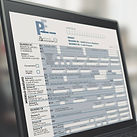Commonly used Income Tax Forms
- _
- Dec 9, 2013
- 2 min read
Most commonly used Federal Income Tax Forms:
There are three types of forms that are used to file Federal Income Taxes by majority of tax payers in America. These are 1040EZ, 1040A and 1040. There are other less common tax forms like 1040PR, 1040NR and 1040X. However we shall confine our discussion to three commonly used forms.
All income should be reported even if you have not received W-2, 1099s or any other relevant forms. It is the taxpayer’s responsibility to keep track of all income received and report it on relevant Income Tax Forms.
Every low income earner does not have to file tax return. If you are single and your gross income is less than $9,350 you do not have to file a tax return. Similarly, if you are married and your joint gross income is less than $18,700 you do not have to file a tax return. However it is a good idea to always file a tax return, even if it is to get the refund of taxes withheld.
Which form you should use:
The form you use, or can use, depends upon your income level, type of income, dependents, age and a few other factors. We are going to discuss these further.
1040 EZ: (click here to download Form 1040EZ)
This form is suitable for singles or married people without any dependents who meet certain requirements. Only two filing statuses are allowed on this form: Single or Married Filing Jointly. Claim fo rdependents is not allowed on this form.
Restrictions:
For 2013, your total taxable income should be less than $100,000.
Interest Income should not exceed $1,500.
Neither you nor your spouse can be older than age 65, nor can you or spouse be blind.
You cannot claim any adjustments to income.
The only tax credit you can claim is Earned Income Tax Credit (EIC).
Your income was only from wages, salaries, tips, taxable scholarships or fellowship grants, unemployment compensation or Alaska Permanent Fund dividends.
You cannot itemize deductions with Form 1040EZ.
Also called a short form, 1040A is a two page form and can be used in more complex situations than 1040EZ. However it also has its limitations. It does not cover a lot of situations that are covered only by Form 1040, also called the long form.
Restrictions:
Your income can be only from wages, interests and dividends, capital gain distributions, taxable grants and scholarships, pensions, annuities, IRA distributions, unemployment compensation, social security, railroad retirement benefits and Alaska Permanent Fund dividends.
Your taxable income is less than $100,000.
You can only claim following adjustments to the income:
Classroom Expenses
IRA Contributions
Student Loan Interest
College tuition and fees.
You cannot itemize deductions.
Not all the tax credits allowable can be taken on Form 1040A
Also called the long form, Form 1040 is the most comprehensive tax form and covers tax situations covered by Forms 1040EZ and1040A. It also covers those situations that are not covered by forms 1040EZ and1040A. Form 1040 can be filed by all tax payers. Form 1040 has attachments, called Schedules, and certain specialized forms and worksheets that need to be filled to explain the details on all the lines on the form.
